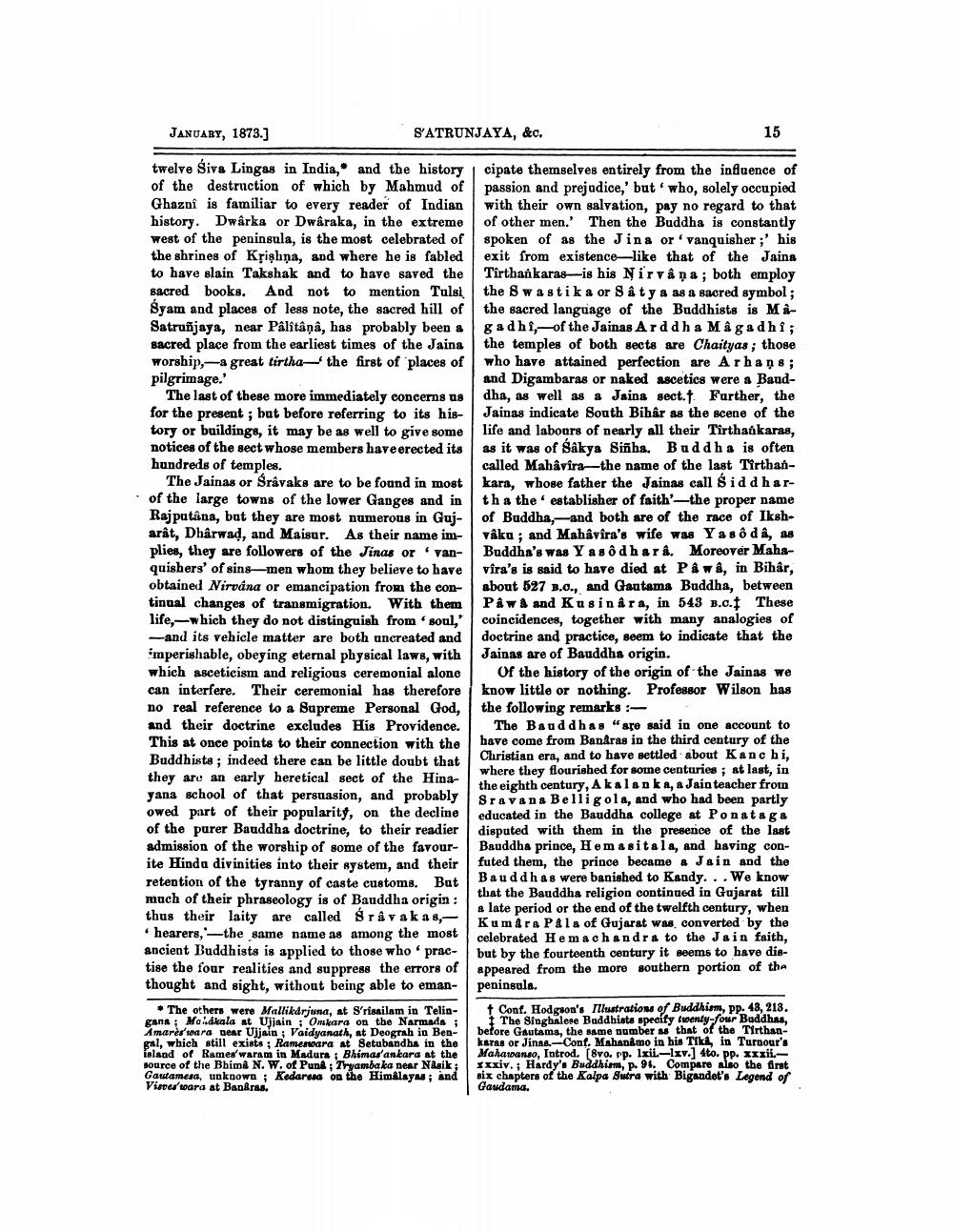________________
JANUARY, 1873.]
twelve Śiva Lingas in India, and the history of the destruction of which by Mahmud of Ghazni is familiar to every reader of Indian history. Dwarka or Dwaraka, in the extreme west of the peninsula, is the most celebrated of the shrines of Krishna, and where he is fabled to have slain Takshak and to have saved the sacred books. And not to mention Tulsi Syam and places of less note, the sacred hill of Satrunjaya, near Pâlîtânâ, has probably been a sacred place from the earliest times of the Jaina worship, a great tirtha- the first of places of pilgrimage.'
S'ATRUNJAYA, &c.
The last of these more immediately concerns us for the present; but before referring to its history or buildings, it may be as well to give some notices of the sect whose members have erected its hundreds of temples.
van
The Jainas or Śrâvaks are to be found in most of the large towns of the lower Ganges and in Rajputana, but they are most numerous in Gujarât, Dharwad, and Maisur. As their name implies, they are followers of the Jinas or quishers' of sins-men whom they believe to have obtained Nirvana or emancipation from the continual changes of transmigration. With them life, which they do not distinguish from soul,' -and its vehicle matter are both uncreated and imperishable, obeying eternal physical laws, with which asceticism and religious ceremonial alone can interfere. Their ceremonial has therefore no real reference to a Supreme Personal God, and their doctrine excludes His Providence. This at once points to their connection with the Buddhists; indeed there can be little doubt that they are an early heretical sect of the Hinayana school of that persuasion, and probably owed part of their popularity, on the decline of the purer Bauddha doctrine, to their readier admission of the worship of some of the favourite Hinda divinities into their system, and their retention of the tyranny of caste customs. But much of their phraseology is of Bauddha origin: thus their laity are called Śrâvakas,hearers, the same name as among the most ancient Buddhists is applied to those who 'practise the four realities and suppress the errors of thought and sight, without being able to eman
The others were Mallikarjuna, at Srisailam in Telingana Manakala at Ujjain Omkara on the Narmada ; Amares wara near Ujjain; Vaidyanath, at Deograh in Bengal, which still exists; Rameswara at Setubandha in the island of Rameswaram in Madura; Bhimas ankara at the source of the Bhima N. W. of Punâ ; Tryambaka near Nasik; Gautamesa, unknown; Kedaresa on the Himalayas; and Visves'wara at Banaras.
15
"
"
| cipate themselves entirely from the influence of passion and prejudice,' but who, solely occupied with their own salvation, pay no regard to that of other men.' Then the Buddha is constantly spoken of as the Jina or vanquisher;' his exit from existence-like that of the Jaina Tirthankaras-is his Nirvâna; both employ the Swastika or S â t y a as a sacred symbol; the sacred language of the Buddhists is Ma ga dhi,-of the Jainas Arddha Magadhi; the temples of both sects are Chaityas; those who have attained perfection are Arhans; and Digambaras or naked ascetics were a Bauddha, as well as a Jaina sect.f. Further, the Jainas indicate South Bihar as the scene of the life and labours of nearly all their Tirthankaras, as it was of Sakya Sinha. Buddha is often called Mahavira-the name of the last Tirthankara, whose father the Jainas call Siddhartha the establisher of faith-the proper name of Buddha,-and both are of the race of Ikshvâku; and Mahâvira's wife was Yasô dâ, as Buddha's was Yasodharâ. Moreover Mahavira's is said to have died at På wâ, in Bihar, about 527 B.C., and Gautama Buddha, between Påwå and Kusinara, in 543 B.c. These coincidences, together with many analogies of doctrine and practice, seem to indicate that the Jainas are of Bauddha origin.
Of the history of the origin of the Jainas we know little or nothing. Professor Wilson has the following remarks :
The Bauddhas "are said in one account to have come from Banaras in the third century of the Christian era, and to have settled about Kanchi, where they flourished for some centuries; at last, in the eighth century, Akalanka, a Jain teacher from Sravana Belligola, and who had been partly educated in the Bauddha college at Ponataga disputed with them in the presence of the last Bauddha prince, Hema sitala, and having confuted them, the prince became a Jain and the Bauddhas were banished to Kandy... We know that the Bauddha religion continued in Gujarat till a late period or the end of the twelfth century, when Kumara Pala of Gujarat was, converted by the celebrated Hemachandra to the Jain faith, but by the fourteenth century it seems to have disappeared from the more southern portion of the peninsula.
t Conf. Hodgson's Illustrations of Buddhism, pp. 48, 218.
The Singhalese Buddhists specify twenty-four Buddhas, before Gautama, the same number as that of the Tirthankaras or Jinas.-Conf. Mahanamo in his Tika, in Turnour's Mahawanso, Introd. [8vo. pp. lxii.-lxv.] 4to. pp. xxxii.xxxiv.; Hardy's Buddhism, p. 94. Compare also the first six chapters of the Kalpa Sutra with Bigandet's Legend of
Gaudama.




